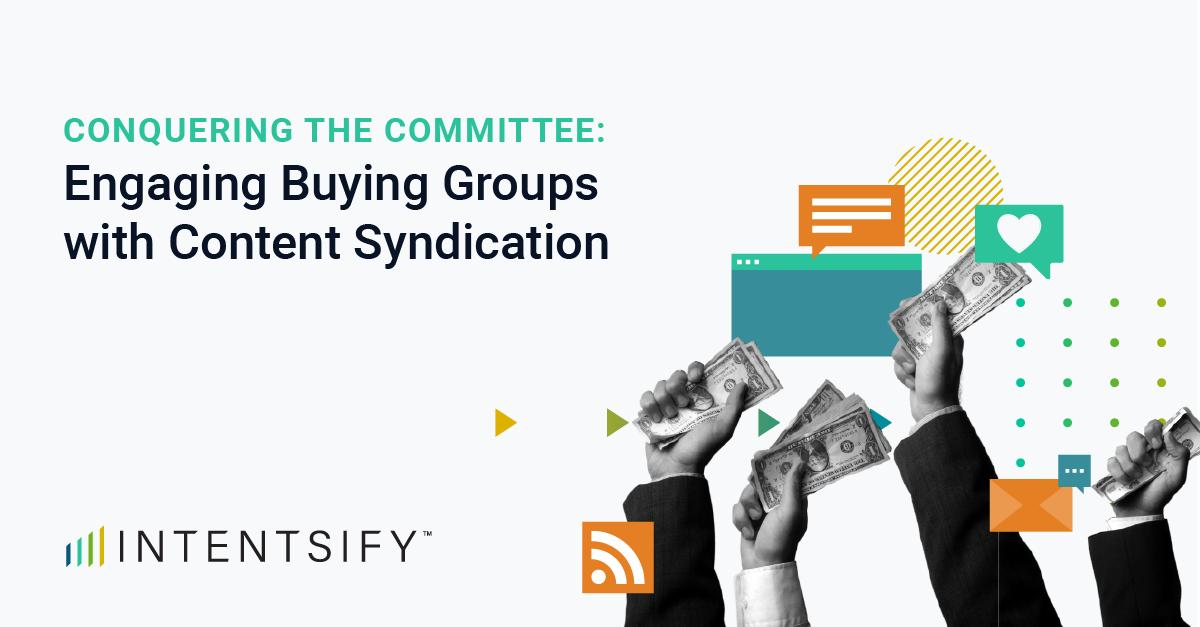You’ve put in the work. You’ve created a killer piece of content — an insightful blog post, an in-depth white paper, an interesting case study. But after the initial buzz fades, what happens? Too often, great content gets buried under a pile of newer assets, collecting digital dust.
The good news? Your best content doesn’t have to be a one-hit wonder or remain stagnant. With smart content repurposing, you can extend the lifespan of your high-performing assets, reach your audience across multiple platforms, and keep your brand message front and center throughout the buyer journey. And when you integrate intent data with your digital programs, you can ensure your repurposed content lands in front of the right audience at the right time.
Read on for tips on how to repurpose content.
Fun Facts:
- The average blog takes nearly four hours to write, according to a survey of over 1,000 bloggers by Orbit Media Studies, although those who spend six or more hours seem to get better results.
- Plus, 65% of those marketers agree that content repurposing is more affordable than creating new content.
- Of 48 marketers surveyed by Referral Rock, 94% said they repurpose content for different mediums and channels. The other 6% said they were thinking about repurposing content in the future.
Why Content Repurposing Matters
You need to work smarter, not harder. Instead of constantly churning out new assets, you can take what you already have and adapt it for different formats and platforms. This approach offers several benefits:
- Expands Your Reach: Some love reading blogs, while others prefer watching videos or scrolling through social media.
- Strengthens Your Message: Sharing the same key points in multiple ways makes your message stick.
- Aligns with the Buyer Journey: Repurposing lets you tailor content for awareness, consideration, and decision-making stages.
- Boosts ROI: You’ve already done the hard work; why not get more mileage out of it?
Now, let’s get into some practical content repurposing strategies.
Turn Long-Form Content into Snackable Social Media Posts
Got a well-researched white paper or a detailed pillar post? Break it down into bite-sized pieces for LinkedIn, Twitter, and other social platforms.
- Key Stats & Insights: Pull out interesting data points and turn them into bite-sized posts.
- Quote Graphics: Highlight impactful quotes from your content and turn them into shareable images.
- Mini-Threads & Carousels: Create Twitter threads or LinkedIn carousels that walk people through the main points.
Bonus tip: Tag industry influencers or companies mentioned in your content to spark engagement.
Convert Blog Posts into Engaging Videos
Not everyone has time to read a 2,000-word blog post, but they might watch a short video. Repurpose your written content into:
- Explainer Videos: Summarize key concepts in a quick, visually appealing format.
- Expert Videos: Have a subject matter expert discuss important points on camera.
- Animated Clips: Use animation to break down complex topics into digestible clips.
Videos work particularly well for display advertising, grabbing attention and driving engagement across digital platforms like TikTok, Instagram, YouTube, and more.
Syndicate Your Content for Maximum Exposure
Content syndication is a powerhouse strategy for demand generation. It allows you to distribute your content across high-traffic sites, putting it in front of audiences actively researching solutions like yours.
- White Papers & Ebooks: Publish gated assets with syndication partners to capture leads.
- Webinar Replays: If you’ve hosted a webinar, syndicate the replay to reach new audiences.
- Guest Articles: Repurpose your blog content into contributed articles for industry publications.
By combining syndication with intent data, you can ensure your content is being seen by accounts actively researching your solution. That way, you’re not just casting a wide net — you’re targeting prospects at the right stage of their buyer journey.
Repurpose Into Display Ads to Stay Top of Mind
Ever had a prospect engage with your content but never take the next step? That’s where display advertising comes in.
- Retargeting Ads: If someone downloads your white paper or reads your blog, follow up with display ads promoting a related case study or demo.
- Educational Ads: Repurpose blog headlines, stats, and important points into banner ads that reinforce your expertise.
- Video Ads: Short clips from webinars, product demos, or expert interviews can make interesting ad content.
When paired with intent data, display advertising allows you to serve relevant content to accounts showing research behavior. This means instead of blasting ads to everyone, you’re focusing your spend on those who are actually in-market.
Transform Case Studies into Multi-Format Content
Case studies are gold for bottom-of-the-funnel marketing, but don’t just leave them in PDF form. Repurpose them into:
- Testimonial Videos: Interview happy customers and turn their stories into engaging clips.
- Slide Decks: Break down case study findings into digestible slides for LinkedIn or webinars.
- Social Proof Snippets: Pull out key results (e.g., “Increased conversions by 75%”) and use them in ads, social posts, and email campaigns.
The key is to make your success stories easy to consume in different formats.
Republish & Refresh High-Performing Content
If you have older content that performed well, don’t let it sit idle. Refresh and republish it to keep driving traffic and engagement.
- Update Stats & Examples: Keep information current and relevant.
- Optimize for SEO: Refresh keywords and internal links to improve rankings.
Google loves fresh content, and so does your audience. But don’t just repurpose anything.
Expert tip: “Not all content deserves a second life,” explains Peter Murphy Lewis, Chief Marketing Officer at Strategic Pete. He notes that the best repurposed content wasn’t created for repurposing. He continues, “It’s the blog post that got people debating in the comments, the podcast episode that unexpectedly went viral, the blog that still brings traffic months after it was posted. So, before you even think about repurposing, take a step back and check: Did this get people talking? Did it get shared?”
Create Infographics to Make Your Content More Visual
Infographics are a powerful way to repurpose content into a visually appealing, easy-to-digest format.
- Summarize Data & Stats: Turn research findings or case study results into shareable infographics.
- Process Overviews: Break down complex processes into step-by-step visuals.
- Comparison Charts: Show product comparisons, industry trends, or before-and-after insights.
Infographics perform especially well on Pinterest, LinkedIn, and as downloadable lead magnets.
Integrate Intent Data to Deliver the Right Message at the Right Time
Repurposing content is powerful on its own, but even more so when you layer in intent data.
Intent data helps you understand:
- Who’s researching your solution
- What topics they’re engaging with
- Where they are in their buyer journey
This means you can strategically deliver repurposed content based on interest and intent.
For example:
- If a prospect is in the awareness stage, serve them blog-based display ads.
- If they’re in the consideration stage, syndicate a white paper or case study.
- If they’re in the decision stage, retarget them with product comparisons or demo invites.
When your content strategy aligns with real-time research behavior, you’re not just repurposing content, you’re activating it to drive real pipeline growth.
Make Content Work For Each Channel
You can’t just slap some insights on social media or other channels in a cookie cutter way. What works on Instagram may not work on Twitter, and what works on TikTok may not work on YouTube.
Lewis explains:
“LinkedIn? Native insights are preferred by the algorithm, so no links, just helpful posts that fit in the feed.
YouTube? Throw on titles, a fresh hook, even a contrarian spin so it seems new.
Blogs? If your podcast guest or interviewee has a strong online presence in their industry (maybe they’re a recognized expert, a CEO, or someone with a big following), propose writing a high-quality blog post for them to post on their site.
Email? The simplest step is to use a top-performing LinkedIn post, expand upon it, and turn it into a straight-to-email discussion.”
It’s important to understand what works for each platform so your content doesn’t get ignored.
Real-Life Example Where Repurposing Content Really Paid Off
Lewis gives an excellent example of repurposing content from a client’s great podcast episode that wasn’t performing as it should have. It only had about 200 listens, but Lewis recognized it had “solid insights, a great guest, all the right ingredients”. He took an edgy portion of the conversation and created a LinkedIn post from it.
He even posted on Reddit. “We reworded it as a considerate reply to a trending discussion within the niche. That post started driving direct traffic back to the podcast page.”
Then he repurposed that content into a guest blog on an industry partner site with the best takeaways, giving him a high-authority back link while boosting SEO.
Then he created a YouTube Short with clips of the best 30 seconds of the podcast.
One content marketing piece that was underperforming at 200 listens skyrocketed to over 20,000 impressions and improved brand visibility across platforms just by, as Lewis puts, “re-packaging it well and showcasing it to the right people in the right ways.”
Work Smarter, Amplify Your Impact
Creating high-quality content takes a ton of effort, but repurposing it strategically helps you get the most out of it. Instead of constantly starting from scratch, think about how you can stretch your best assets across multiple formats and platforms.
And when you add content syndication, display advertising, and intent data into the mix through integrated campaigns, you ensure your content reaches the right people at the right time.
So before you jump into your next content piece, ask yourself: How else can I use this? Chances are, your best content still has plenty of life left in it. You just need to unlock its full potential through content repurposing and recycling.






